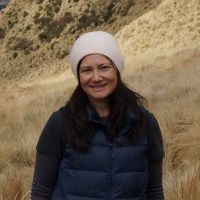Cambeiro et al., 2018
Imaging the critical zone structure using seismic refraction in Garner Run at the Susquehanna Shale Hills Critical Zone Observatory
Joaquin Cambeiro, Angelo Tarzona*, Yonesha Y Donaldson, Gina Pope, Paul O'Neill, Jorden L Hayes, Gregory Mount, Kristina Keating, Susan Brantley, Jonathan Nyquist (2018)
Abstract NS41B-1159 presented at 2018 AGU Fall Meeting, Washington, D.C., 10-14 Dec
-
Shale Hills, Sierra, INVESTIGATOR, COLLABORATOR
-
Shale Hills, INVESTIGATOR, COLLABORATOR
-
Shale Hills, INVESTIGATOR, COLLABORATOR
-
National, Eel, Luquillo, Shale Hills, INVESTIGATOR, COLLABORATOR
-
Christina, Shale Hills, COLLABORATOR
Abstract
Understanding the subsurface structure of the critical zone allows us to better understand processes such as erosion and weathering that shape landscapes and support life at the surface. Our research focused on determining the thickness of the sediment and the depth to quartzite bedrock in the Garner Run catena of the Susquehanna Shale Hills Critical Zone Observatory. During the Last Glacial Maxima, Garner Run was affected by periglacial processes even though it was not glaciated. These periglacial processes, such as freezing, thawing, and the movement of this frozen water caused sediments to be transported and deposited at Garner Run. Using a 2D seismic refraction tomography survey we imaged the subsurface seismic velocity structure. Seismic refraction surveys were oriented perpendicular to the valley axis with 2 to 3 m geophone spacing; a 280 m roll-along seismic refraction tomography survey was set up roughly parallel to the valley axis using a 4 m geophone spacing. Based on the tomographic model, we interpret three dominant layers with velocities that range from 421 to 1110 m/s, 1800 to 2500 m/s, and 3180 to to 3868 m/s. We interpret these layers as periglacial fill, fractured sandstone, and bedrock, respectively.
This research was performed as part of the 2018 Geopaths Near Surface Geophysics Field Experience program, a collaborative project between Rutgers University Newark, Temple University, Indiana University of Pennsylvania, Penn State University, and Dickinson College. The program brought together 17 freshman and sophomore undergraduate students that were guided by 4 peer mentors. Many of the students were non-geoscience majors and/or from under-represented minority backgrounds. The objective was to draw interest in the geosciences and introduce these students to basic near-surface geophysical methods.
Citation
Joaquin Cambeiro, Angelo Tarzona*, Yonesha Y Donaldson, Gina Pope, Paul O'Neill, Jorden L Hayes, Gregory Mount, Kristina Keating, Susan Brantley, Jonathan Nyquist (2018): Imaging the critical zone structure using seismic refraction in Garner Run at the Susquehanna Shale Hills Critical Zone Observatory. Abstract NS41B-1159 presented at 2018 AGU Fall Meeting, Washington, D.C., 10-14 Dec .
 This Paper/Book acknowledges NSF CZO grant support.
This Paper/Book acknowledges NSF CZO grant support.
Explore Further





